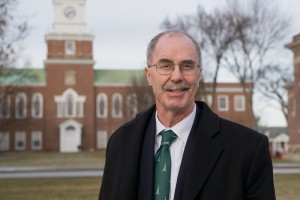
On the first day of classes this term, President Hanlon emailed the student body to share his thoughts on the broad moment in American higher education.
On the first day of classes this term, President Hanlon emailed the student body to share his thoughts on the broad moment in American higher education. Like most of Hanlon’s increasingly frequent messages to campus, the email had the flavor of a Fireside Chat: charmingly light on substance, but still a useful recap of the administration’s thinking.
“In fact, the liberal arts have never been more relevant,” he wrote, responding to the notion that Dartmouth’s teaching-first, hard skills-second model is losing value. Hanlon’s tone was almost defiant, but in fact, the value of the liberal arts is not nearly as disputed today as it was just five or so years ago. When the tech sector first started to dominate our imagination of what the future workforce would look like, public officials and academics alike pitched ramped-up STEM education as the only way to keep graduates prepared. But a tide of recent thinkpieces suggests that a big correction to this mindset is underway, at least among the intelligentsia. As Dartblog editor Joe Asch ’79 pointed out in a January 9 post, the liberal arts thriving again.
This resurgent faith in knowledge-focused education boils down to the need for soft skills to cultivate the growth of both traditional and more technical industries. Where we once predicted a twenty-first century workforce dominated by professionals with the strongest technical skills, it’s become increasingly clear that practical talents like IT service and mechanical maintenance are likely to become commoditized as the labor market becomes more global, and more workers can afford a basic education. Dartmouth can offer its students a stellar computer science curriculum, but all our resources and star professors will only give graduates a marginal leg up on their competitors if their coding skills are complimented by a free-thinking development mindset.
The College recently publicized a Washington Post essay that applied this same principle to the world of medicine. David Silberweig ’82, Chairman of Psychiatrics at the Brigham & Women’s Hospital in Boston, told a by now familiar type of story about how he stretched his brain with a philosophy, and has seen his medical and management skills enriched by what he learned. By his description, Dartmouth gave him all the pre-med basics plus the perspective to apply them in a conscientious way.
As the College now proceeds more confidently with its traditional teaching focus, the key will be ensuring that this mix of practical and creative skills is available to all. So how are we doing? One year ago, The Dartmouth Review interviewed President Hanlon to get some specifics about his silver bullet for this challenge: experiential learning. At the time he recalled a long list of courses across various departments that already incorporate hands-on exercises in their curricula, like an engineering course in which students design functional structures for businesses and charities in the Upper Valley. But by his telling, these scattered courses were just the precursors to a more standardized way of unifying creative thinking and active practice.
Now, one year after that conversation, Hanlon’s vision has begun to manifest in a fairly remarkable way. As part of the academic component of Moving Dartmouth Forward, he established the Experiential Learning Initiative (ELI) this fall, a program within the Dartmouth Center for the Advancement of Learning. The ELI will allow professors and staff members to apply for grants to fund experiential learning projects within their departments. The program has three levels of funding at $2,500, $10,000, and $25,000, and the directors hope to award up to eight grants at the two lower levels and two at the highest amount.
If professors are proactive about dreaming up projects that align with the ELI’s criteria, this new structure may prove to be a perfect approach to spreading the learning-doing synthesis far and wide across every department. Encouraging individual professors to take initiative on their own independent concepts resembles the Department of Education’s successful Race to the Top program, in which states receive federal school funding based on the strength of their reform proposals in a competitive selection process. Rather than create one highly visible but free-standing center for experiential learning a la the Duke University’s “Duke Engage” program, Dartmouth has made a bet that it can stitch practical education into the heart of our curriculum. This approach does more than put professors in the driver’s seat. Making regular classes the main pathway to experiential learning ensures that more than just the most proactive students will stumble into opportunities to engage with it, building their skills and hopefully getting a better sense of the purpose of the material they’re studying.
Over the coming terms, we’ll hopefully begin to see ELI’s seed projects blossoming from department to department. Students who hope to someday thrive in one of the many industries that combines hard skills with creative flourish should keep their eyes peeled from term to term, seeking out the professors and courses that have mastered the blend.

Be the first to comment on "Creative Learning Bearing Fruit"